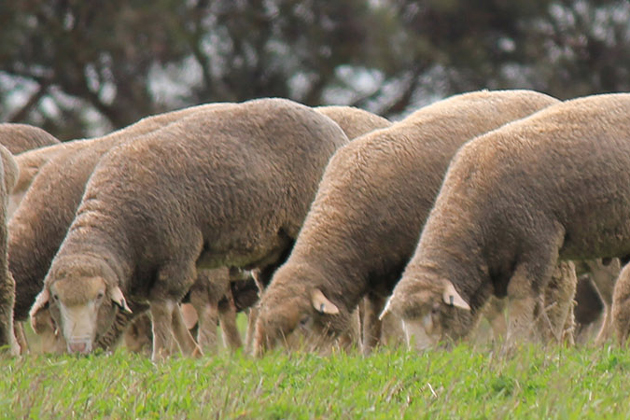Merino and Dohne Genetic Trends

The overall breed genetic trait trends for MERINOSELECT and DOHNE show gains in key economic traits. The overall Merino breed gains are an aggregate of the Superfine, Fine, Medium wool Australian types and Merinos from New Zealand (not shown in the table available below). Each type has some similar but also different trait trends compared to other types and the breed.
The breed and type trends are impacted by new breeders entering animals and by an increasing number of existing animals being assessed for a wider range of traits, such as wrinkle. There are individual ram breeders making faster progress than the average of the types or breed suggest.
The breed and type trends available in the table below come from animals bred by ram breeder members of MERINOSELECT and DOHNE genetic evaluations; they do not include animals from R&D flocks such as MLP, Sire Evaluation or MLA Resource Flocks (noting the MERINOSELECT and DOHNE evaluations are two separate analyses and cannot be compared to each other). Animals from the 2022 drop are not included as all the records up to 2-year-old for the drop are yet to be collected and analysed. The figures opposite are average and not median figures. The breed average for the 2021 drop is -0.22 but the MERINOSELECT 50 percentile ‘median’ was -0.3. The high wrinkle animals are dragging the average higher to -0.22.
The number of Merino animals recorded from the 2000 to 2020 drop has increased from 20,638 to 158,341, the number of dag records has increased from 80 to 16,926 and the number of wrinkle records has increased from zero to 50,283. The large increase in numbers may be inflating or deflating the reported versus real genetic trends. However, as the number of recorded animals increases, the reported figure will be closer to the real industry trend.
Comments on the reported trait ASBV genetic trends since year 2000 are:
- Birth Weight (BWT) has increased by breed and type, by a consistent 0.3 kg over the last 20 years.
- Yearling Weight (YWT) has increased by 3.5 to 5.3 kgs and Adult Weight (AWT) by 2.2 to 4.8 kgs over the last 20 years with the least gains being made by the Medium Merino type.
- There is a slight decrease in Yearling Fat (YFAT) in the Merino and Dohne breeds over 20 years with a large decrease in the Superfine type and an increase in the Medium type.
- The Merino breed has had a modest increase in Yearling Muscle (YEMD) over the last 20 years, with the Medium Merino type and Dohnes having larger increases.
- The largest gains in Yearling and Adult Fleece Weight (YGFW and ACFW, respectively) have occurred in the Superfine types with the least gain in the Medium Merino type and Dohne. The Fine types are the heavier cutters, however these trends need to be put in perspective with the differences in fibre diameter, wrinkle, and wool colour trends.
- The Merino Breed and Superfine type Fibre Diameter fell from 2000 to 2010 but increased from 2010 to 2020 showing little change over the 20 years. However, the Fine (-0.37), Medium (-1.15) and Dohne (-0.49) type trends has seen a constant fall in fibre diameter over the 20 years.
- The Superfine type has increased in Wrinkle (EBWR) with the large increase in fleece weight. The other types and Dohnes have decreased in wrinkle over the last 15 years. For the 2021 drop, the Superfine type averaged +0.11, the Fine type -0.08 and the Medium type -0.48. This shows large differences in wrinkle between the Merino types. The New Zealand Merino Breech Wrinkle for the 2021 drop is -0.17 (not shown in the table available below).
- There are much fewer on-farm records for Wool Colour (LCOL) but there are reasonable differences between the Merino types; Superfine is -0.58, Fine is -0.21 and Medium is +0.09, with similar differences between types for Fleece Rot (LFROT). It illustrates the difficulty in taking low wrinkle Medium types into high rainfall areas, and risk of shifting strike from the breech to the body.
- Merino Weaning Rate (WR) and its component traits of conception (CON), litter size (LS) and ewe rearing ability (ERA) are new reproduction traits. The 2021 drop Weaning Rate ASBV for Superfines is 0.07, Fine is 0.13 and Medium is 0.11, reflecting the Superfine lower body weights and higher wrinkle, while these associations are less obvious in the Fine and Medium type averages. The differences in Conception between types are small, with larger but still modest differences in Litter Size and Ewe Rearing Ability. MLP results are showing sires with high and low Weaning Rate in all Merino types.
- The Yearling Worm Egg Count (YWEC) ASBVs are trending lower but erratically and could be caused by very variable seasons in high worm regions and less emphasis on worms following a run of dry years.
- Meat eating quality in Merinos is high but the trends (from genomics) are modestly unfavourable with falling Intramuscular Fat (IMF) and increasing Shear Force (SF5). There has been limited selection of these traits to date and trends a result of correlations with higher body weight and muscle.
- The Indexes are all increasing but for a range of different reasons highlighted above.
The trends show that most on farm selection emphasis is on the lead economic traits, but they also show that when market trends change (fine wool micron premium in recent years and move to lower wrinkle), it does take time to shift the momentum, particularly when the number of new incoming animals could be masking underlying trends.
Individual breeders are making much larger gains that the averages suggest.
View the Breed and Type Trends table here.
More information: Geoff Lindon, AWI Program Manager Genetics and Animal Welfare Advocacy, Geoff.Lindon@wool.com















